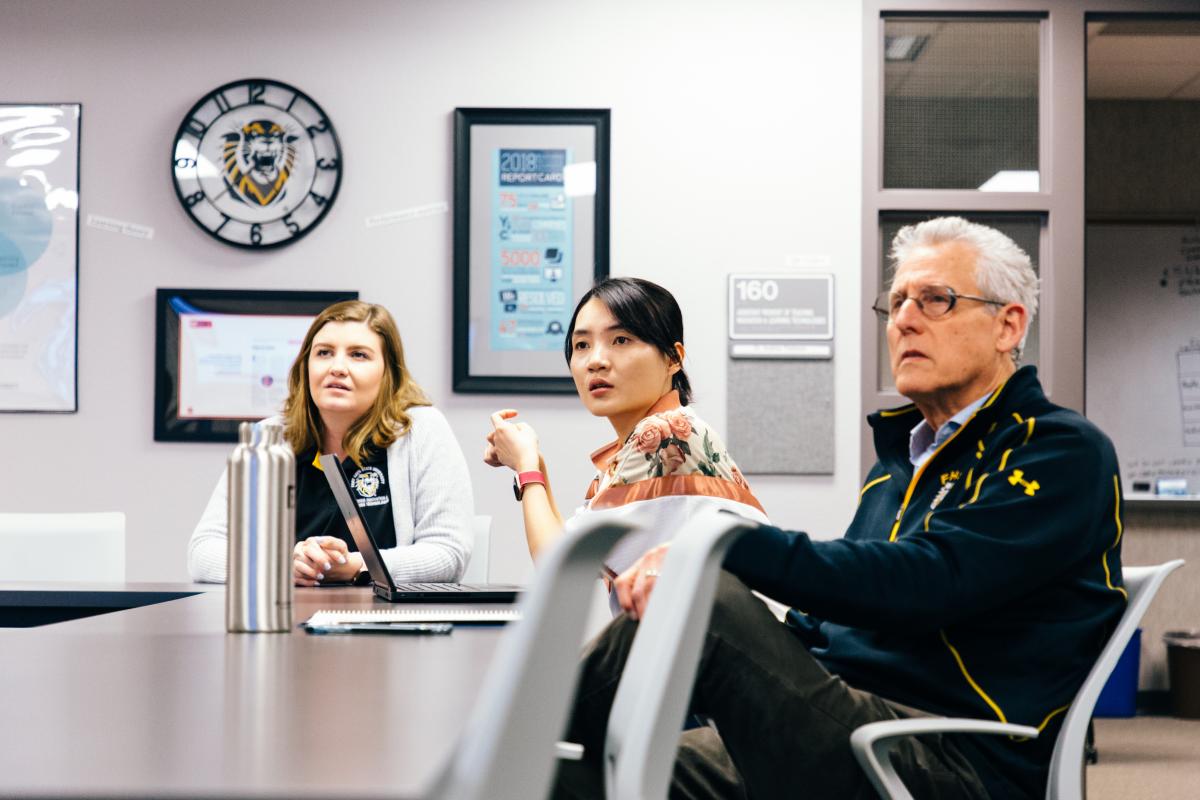You have /5 articles left.
Sign up for a free account or log in.

Duke Kunshan University campus
Duke University
After celebrating the Lunar New Year earlier this month, thousands of students at U.S. universities in China have resumed classes. But the campuses are eerily quiet, and classrooms remain empty. That's because classes have moved online in the wake of the coronavirus.
The transition from face-to-face to fully online wasn’t one leaders at institutions such as Duke Kunshan University and New York University Shanghai had planned for. Preparing to teach a course online for the first time usually takes several months. Faculty at institutions in China have done it in less than three weeks -- a remarkable feat.
“It’s been highly stressful, but at the same time, the clarity of the crisis has brought us together,” said Clay Shirky, vice provost for educational technologies at NYU in New York, who was part of the team that helped colleagues at NYU Shanghai launch their courses online.
Faced with the decision to either close the Shanghai campus and suspend teaching indefinitely or try and keep students on track, leaders at NYU chose the latter, said Shirky. “It took us a while to realize that we really needed to move the semester online,” he said. “Looking back, I wish we had made the call a little earlier.”
Hopeful that students would be able to return to campus after the holidays, NYU Shanghai planned to reopen on Feb. 3. When travel restrictions were introduced, the semester's start date was pushed to Feb. 10. Then the Chinese Ministry of Education ordered universities across the nation not to reopen their doors, leaving faculty with a tight deadline to move classes online.
So far, things are going surprisingly well, said Jace Hargis, director of the NYU Shanghai Teaching and Learning Center. He has been closely monitoring progress since classes began Feb. 17. Initial student feedback has been good, and faculty members report feeling increasingly confident in their ability to teach online, he said. The vast majority of faculty -- 88 percent -- did not have significant experience teaching online previously.
“Before day one, a lot of faculty said they were feeling a bit anxious. They weren’t sure what students would think,” said Hargis. “Now they’re feeling a lot better.”
NYU Shanghai faculty aren’t just located in China. Many traveled all over the world during the recent holiday. Now flight restrictions in and out of China mean they can’t go back to their homes. Students, too, are scattered across the globe.
Working across different time zones has been challenging but not impossible, said Hargis. “Ten years ago, we wouldn’t have been able to do this -- the technology wasn’t there,” he said. High-speed internet and advancements in videoconferencing technology made communication much easier.
Through webinars, specially-created online resources, one-on-one consultations, drop-in online office hours and many, many emails, an international team worked with NYU Shanghai faculty to move almost 500 classes online.
“It was a lot of overtime for three weeks, but time well spent,” said Xiaojing Zu, library director at NYU Shanghai in an email. “We already had a collection of ed-tech platforms and tools and tested pedagogies we had been working with faculty to utilize. It was a matter of introducing these tools and methods to more than one hundred faculty in a short time.”
Training sessions focused on teaching faculty to teach with two video-sharing platforms, Zoom and VoiceThread, said Hargis. These tools enable faculty members to teach synchronously or asynchronously as they see fit. To break down the workload, faculty were encouraged to focus on preparing the first two weeks of the 14-week semester. Faculty and students have access to a chat service that operates for 16 hours a day if they have any questions or need help.
For some instructors, moving courses online was a challenge. But so far, the distance learning effort is yielding promising early results.
For example, Hargis said he worked closely with visiting assistant professor of mathematics Leonardo Rolla, who is currently based in Argentina. “We suggested a lot of things to try and create a caring classroom culture online,” said Hargis. Rolla created an introductory video walking students through the syllabus. He then asked each student to make a video introducing themselves. For their first assignment, students had to film themselves explaining how they would solve an example exercise. Almost all created high-quality videos, with one student sharing that he actually preferred these activities to face-to-face teaching.
Scott Warnock, director of the university writing program at Drexel University, was asked to lead a workshop to help a small group of NYU Shanghai faculty members foster pedagogies specific to teaching writing online. Teaching writing online isn’t straightforward, but there are lots of ways you can engage students using discussion boards, he said. You can assess a student’s ability to present an argument, for example, by asking them to respond to provocative statements such as “students should pay more for college." Warnock likes to post these statements under a pseudonym such as Dr. Logoetho. “It’s tongue-in-cheek and playful. It’s one of my students’ favorite exercises,” he said.
At Duke Kunshan University, faculty had a similarly tight window to put their courses online. Classes started online yesterday after just three weeks’ preparation, said Scott MacEachern, interim vice chancellor for academic affairs at the university. “There were a lot of discussions between DKU and Duke around whether we could really do this, and we decided, yes, we can. Duke has a lot of capability online, and DKU is just 18 months old at this point. Our students and faculty are pioneers. We wanted to keep the energy up.”
NYU and Duke are not the only universities to take classes in China online. Universities across the country are embarking on similar efforts, many utilizing free content from new national massive open online course providers. Coursera, a U.S. based MOOC provider, has made its courses freely accessible to Duke Kunshan students. Matthew Rascoff, associate vice provost for digital education and innovation at Duke, said the offer has proven very popular with students. Online learning at the degree level has long been restricted in China because of concerns about regulation and quality, but Ministry of Education rules have been relaxed to ensure students "keep learning, even with classes suspended."
Whether China's temporary embrace of online learning results in long-term change, remains to be seen. Rascoff is hopeful that at Duke Kunshan at least, the experience will be beneficial. The experience of teaching online can make instructors better teachers in any environment, he said.
In addition to ensuring faculty and students are safe and healthy, Duke Kunshan and NYU Shanghai have made it easier for students to transfer to other university campuses or postpone their classes. Both institutions have made funds available to students to ensure they have access to high-speed internet and working laptops, tablets or smartphones.
At Fort Hays State, faculty have worked hard to ensure the content they take online is accessible to all students, said Andrew Feldstein, assistant provost for teaching innovation and learning technologies at the university. Fort Hays offers several degree programs through two partner Chinese institutions. “We made making everything mobile-friendly a priority, which added to the challenge,” he said.
It’s been an extraordinary team effort to get ready for the start of the semester, said Feldstein.

"The first thing I thought when I heard the campuses were closed was that this could be a real opportunity for us," said Feldstein. "Often we're slowed down by processes that we don't even question anymore. This allowed us to look at everything in a new light."




